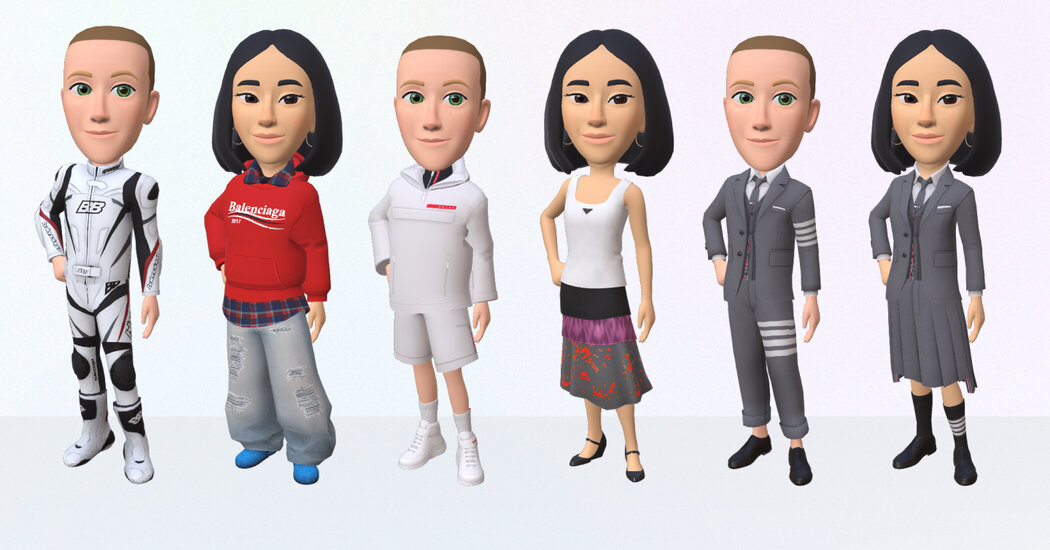
So that’s it.
Last October, after Mark Zuckerberg had unveiled his vision for the new Meta (formerly Facebook) and the amazing future that awaited in Web 3.0, and been roundly teased for his decision to do so via an avatar wearing exactly the same thing Mr. Zuckerberg wears in his everyday life — this, in a world of infinite possibility! — Meta picked up on the problem and threw down a gauntlet of sorts.
“Hey, Balenciaga,” the company tweeted, “What’s the dress code in the metaverse?”
This week Balenciaga responded, along with Prada and Thom Browne, courtesy of Meta’s new avatar fashion store, which began a rollout to users in the United States, Canada, Thailand and Mexico. Though the social media company had offered a variety of free (and generic) outfits for avatars used on Facebook, Instagram, and Messenger, this is the first time it has enlisted named designers to create looks-for-purchase for virtual selves.
And the answer is … a red Balenciaga logo hoodie.
Also some ripped jeans and a plaid shirt, a motocross jumpsuit, a black skirt suit, and low-rise jeans paired with a crop logo tee and logo briefs (four outfits in total). Quintessential Balenciaga looks, in other words, for anyone who has followed the brand. Just as Thom Browne’s offering, a shrunken gray three-piece suit, pleated gray skirt suit and shorts outfit is Mr. Browne’s trademark uniform. And as at least one of Prada’s four looks — a white tank top with logo triangle and tiered skirt — seemed to come straight from the most recent runway (though they, too, offer the perennial logo sweatshirt).
But still, that’s it?
These are four of the most creative, considered fashion designers working today — Demna Gvasalia of Balenciaga, Miuccia Prada and Raf Simons of Prada, and Mr. Browne — designers whose clothes IRL grapple with the way social and political forces shape identity at the most essential levels; designers whose work has tackled climate change, gender, war, capitalism, questions of value and viral celebrity. And all they (or maybe their digital, merchandising and marketing teams) could come up with when tasked to imagine dress in a space unbound by gravity and any kind of physical limitation are cartoon copies of among the most familiar clothes they already sell?
Well, Mr. Browne emailed when asked how he chose his outfits, “it took me two seconds, no one second, to know what it needed to be. I thought the gray suit needed to engage in this world.”
The argument is that simply by making these clothes, which normally sell for hundreds and thousands of dollars, available to a wider group of users (in the Meta store the price range is $2.99 to $8.99), they are democratizing the otherwise inaccessible. Which is true, commercially speaking, and essentially positions the Meta looks as the NewGen equivalent of a lipstick: the ultimate in diffusion lines, almost all barriers to entry erased.
And while it is good that the tech world, which has shied away from fashion since the attempt to make wearables chic fell pretty much flat on its face, realizes that if it wants to play in the world of dress, best to invite the experts in, these particular offerings seem predicated on the lowest common expectations of our selves in the virtual world.
The whole point of the kind of fashion Mssrs. Gvasalia et al. create is that it is more than commercial: It shows us who we are, or who we want to be, at a specific moment in time in ways we didn’t even understand until we see it.
If any creative minds were going to be able to imagine how a paradigm shift might look, you’d think it would be them.
Mr. Browne already does this sometimes in his IRL shows. Recently he designed a top that looked like a giant cable-covered cross between a tennis ball and a turtle carapace, and turned a woman into a toy soldier. Mr. Gvasalia takes the everyday — terry-cloth bathrobes, Ikea bags — and makes it extraordinary by subverting all expectations. You’d think the leap to the metaverse would be a no-brainer for them.
Yet what the “clothes” this troika have designed for the Meta store show seem to be, largely, are an opportunity to show off brand allegiance and leverage their archives in the most straightforward ways. The implication is that users want to wear the same clothes in a digital space as they do in a physical space — or at least the same clothes they aspire to wear — rather than something entirely new.
In an Instagram Live conversation with Eva Chen, the director of fashion partnerships for Instagram, introducing the new store, Ms. Chen flashed sketches of Mr. Zuckerberg’s avatar in different outfits and quizzed him on his reactions. “It does take a certain confidence to wear shoulders-to-toe Prada,” Mr. Zuckerberg said, suggesting he did not have that confidence IRL, though he might in the metaverse.
But that’s a fundamental misunderstanding of fashion — and the whole idea of self-expression. After all, who wears a look entirely from one designer in real life? Celebrities paid by the brand in public situations, fashion victims and models in magazine shoots in which the brand will lend clothes only if they aren’t mixed with the work of other designers.
In a Facebook post on the store, Mr. Zuckerberg also said that Meta wanted to create an avatar fashion offering because “digital goods will be an important way to express yourself in the metaverse and a big driver of the creative economy.” But self-expression is not about swallowing a designer look whole. Self-expression is about using the tools designers create to make something individual.
It doesn’t take confidence — it doesn’t even take thought — to wear a look entirely dictated by a designer. It simply takes the desire to be a vehicle of brand advertising, which is what Meta is currently facilitating. Maybe that’s really where some users want to go (maybe that’s always been a fantasy), but that’s not going to lead to an expansion of the world as we know it, but rather yet more factionalization.
Especially because avatars are not cross-platform creations. So if you want the virtual you to wear Prada — or Balenciaga or Thom Browne — you can do it only on Meta platforms. Just as if you wanted the virtual you to wear Tommy Hilfiger, Ralph Lauren or Gucci, you have to be on Roblox.
To be fair, maybe this will change as technology changes, just as the ability to dress your avatar may change. Right now, when you pick any kind of an outfit in the Meta wardrobe, you have to choose an entire premade look rather than being able to build with one garment at a time. In the future, perhaps, a Balenciaga hoodie could be paired with a Prada skirt and a pair of no-name shoes.
Mr. Zuckerberg has said that at some point Meta will open the store to digital-only fashion brands and other new creatives — the sort of designer/inventors already selling their wares on the digital marketplace DressX, which is where most of the truly alternative interpretations of “clothes” can be found.
If so, getting your avatar dressed in the morning may feel less like playing paper dolls, and more like a unique form of value-signaling and experimentation; may seem additive, rather than just imitative. But not yet.

